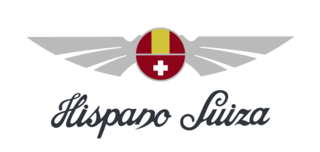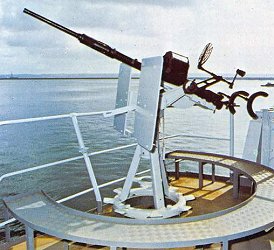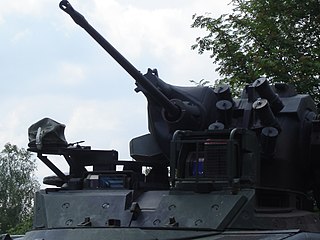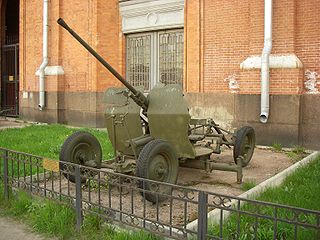
An autocannon, automatic cannon or machine cannon is a fully automatic gun that is capable of rapid-firing large-caliber armour-piercing, explosive or incendiary shells, as opposed to the smaller-caliber kinetic projectiles (bullets) fired by a machine gun. Autocannons have a longer effective range and greater terminal performance than machine guns, due to the use of larger/heavier munitions, but are usually smaller than tank guns, howitzers, field guns or other artillery. When used on its own, the word "autocannon" typically indicates a non-rotary weapon with a single barrel. When multiple rotating barrels are involved, such a weapon is referred to as a "rotary autocannon" or occasionally "rotary cannon", for short.

Hispano-Suiza is a Spanish automotive–engineering company. It was founded in 1904 by Marc Birkigt and Damian Mateu as an automobile manufacturer and eventually had several factories in Spain and France that produced luxury cars, aircraft engines, trucks and weapons. In 1923, its French luxury car arm became a semi-autonomous partnership with the Spanish parent company. In 1946, the Spanish parent company sold all of its Spanish automotive assets to Enasa, a Spanish state-owned vehicle manufacturer, and the French arm continued as an independent aviation engine and components manufacturer under the Hispano-Suiza name. In 1968, Hispano-Suiza was taken over by the aerospace company Snecma, which is now part of the French Safran Group. An attempt to relaunch the marque was made by the company Hispano Suiza Cars associated with the Peralada Group in 2019 with a fully-electric car.

A revolver cannon is a type of autocannon, commonly used as an aircraft gun. It uses a cylinder with multiple chambers, like those of a revolver handgun, to speed up the loading-firing-ejection cycle. Some examples are also power-driven, to further speed the loading process. Unlike a rotary cannon, a revolver cannon only has a single barrel, so its spun weight is lower. Automatic revolver cannons have been produced by many different manufacturers.

The HS.404 is an autocannon originally designed and produced by Spanish/French company Hispano-Suiza in the mid-1930s. It was widely used as an aircraft, naval and land-based weapon by French, British, American and other military services, particularly during World War II. The cannon is also referred to as Birkigt type 404, after its designer Marc Birkigt and later versions based on British development are known as 20 mm Hispano.

The MG FF was a drum-fed, blowback-operated, 20 mm aircraft autocannon, developed in 1936 by Ikaria Werke Berlin of Germany. It was a derivative of the Swiss Oerlikon FF F cannon, with the Oerlikon FF design itself a development of the Imperial German World War I Becker 20 mm cannon, and was designed to be used in space-limited, fixed mountings such as inside aircraft wings, although it saw use as both an offensive and a defensive weapon, in both fixed and flexible format. It saw widespread use in those roles by the German Luftwaffe, particularly during the early stages of World War II, although from 1941 onwards it was gradually replaced by the Mauser firm's 20 mm MG 151/20, which was lighter, and had both a higher rate of fire and muzzle velocity.

The M242 Bushmaster chain gun is a 25 mm (25×137mm) single-barrel chain-driven autocannon. It is used extensively by the U.S. military, such as in the Bradley fighting vehicle, as well as by other NATO members and some other nations in ground combat vehicles and various watercraft. Hughes Helicopters in Culver City, California, was the original designer and manufacturer. McDonnell Douglas Helicopters acquired Hughes Helicopters in 1985, and merged into Boeing Corporation in 1997. In 2002, it was sold again to Alliant Techsystems, which merged with Orbital Sciences Corporation in 2015 to form Orbital Science ATK and was, in turn, bought out by Northrop Grumman in 2018. As of 2019, Northrop Grumman Innovation Systems produces the gun.

The FF were a series of 20mm autocannon introduced by Oerlikon in the late 1920s. The name comes from the German term Flügel Fest, meaning wing mounted, fixed, being one of the first 20mm guns to be small and light enough to fit into a fighter aircraft's wing. The FF series inspired many 20mm cannon used in World War II, including the Hispano-Suiza HS.404, the German MG FF, and the Japanese IJNAS's Type 99 cannon.

The Oerlikon 20 mm cannon is a series of autocannons based on an original German Becker Type M2 20 mm cannon design that appeared very early in World War I. It was widely produced by Oerlikon Contraves and others, with various models employed by both Allied and Axis forces during World War II. Many versions of the cannon are still used today.

The 20 mm modèle F2 gun is a naval defence weapon used by the French Navy. It was developed from the GIAT M693, itself derived from Hispano-Suiza HS.820. It fires the same 20×139 mm round.

The Oerlikon GDF or Oerlikon 35 mm twin cannon is a towed anti-aircraft gun made by Oerlikon Contraves. The system was originally designated 2 ZLA/353 ML but this was later changed to GDF-001. It was developed in the late 1950s and is used by around 30 countries.

The Rheinmetall Mk 20 Rh-202 is a 20 mm caliber autocannon designed and produced by Rheinmetall. It fires the 20×139mm ammunition originally developed for the Hispano-Suiza HS.820.

The Flak 30 and improved Flak 38 were 20 mm anti-aircraft guns used by various German forces throughout World War II. It was not only the primary German light anti-aircraft gun but by far the most numerously produced German artillery piece throughout the war. It was produced in a variety of models, notably the Flakvierling 38 which combined four Flak 38 autocannons onto a single carriage.

The M45 Quadmount was a towed anti-aircraft gun consisting of four .50 caliber M2 Browning machine guns mounted in pairs on either side of an armored open-top gunner's compartment with electrical laying. It was developed by the W. L. Maxson Corporation to replace the earlier M33 twin mount. Although designed as an anti-aircraft weapon, it was also used against ground targets, where it earned the nicknames "meat chopper" and "Krautmower" Introduced in 1944, it saw service as late as the Vietnam War.

The Hispano Aviación HA-1109 and HA-1112 are licence-built versions of the Messerschmitt Bf 109 G-2 developed in Spain during and after World War II.

The Ho-5 was a Japanese aircraft autocannon used during World War II. Developed from the Ho-103 machine gun, it was a version of the American Model 1921 Browning aircraft machine gun. It replaced the Ho-1 and Ho-3 in general service. The Ho-5 was belt-fed using typical Browning-style steel disintegrating links. The cartridge used was a shortened version of the Allied 20 x 110mm Hispano-Suiza HS.404.
The Rheinmetall-Borsig MK 103 was a German 30 mm caliber autocannon that was mounted in German combat aircraft during World War II. Intended to be a dual purpose weapon for anti-tank and air-to-air fighting, it was developed from the MK 101. Compared to the MK 101 it was faster firing, and was originally intended to develop a higher muzzle velocity than the MK 101. Unlike the MK 101, the MK 103 used a belt feed, allowing it to potentially carry a larger ammunition load. The MK 103 used electrically primed rather than percussion-primed ammunition. The operating mechanism differed from the recoil-operated MK 101 in that it used a combination of gas and recoil operation. After firing, gas pressure served to unlock the breech, while barrel recoil was used to cycle the action.

25 mm automatic air defense gun M1940 (72-K) was a Soviet 25 mm caliber anti-aircraft gun used during the Great Patriotic War. The gun was developed from the end of 1939 to the beginning of 1940 at 8th Kalinin Artillery Plant under the guidance of its Chief Designer Mikhail Loginov, supervised by Lev Loktev. The cannon was given the factory code 72-K before being accepted into service by the Red Army as the 25 mm automatic air defense gun M1940.

The Rheinmetall Oerlikon Millennium Gun or Rheinmetall GDM-008 is a close-in weapon system designed by Rheinmetall Air Defence AG for mounting on ships. It is based on the 35/1000 revolver gun land-based air defense system and uses Advanced Hit Efficiency And Destruction (AHEAD) ammunition.

The Zastava M55, also designated 20/3-mm-M55, is a Yugoslavian/Serbian 20mm triple-barreled automatic anti-aircraft gun developed in 1955 and produced by Crvena Zastava in Kragujevac, Serbia, for Yugoslav People's Army use and also for the export market. In addition to the basic towed model M55 A2, the variants M55 A3 B1, M55 A4 B1 and the BOV-3 SPAAG were also developed.

The KCB is a 30 mm caliber autocannon, developed by Hispano-Suiza as HS.831. When Oerlikon purchased Hispano's armaments division, the gun became KCB.




















